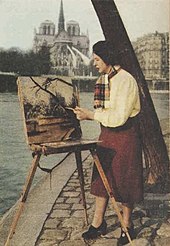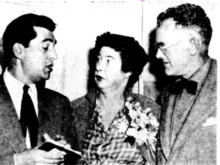Moya Dyring
Moya Claire Dyring (born February 10, 1909 in Coburg , Australia , † January 4, 1967 in Wimbledon , United Kingdom ) was an Australian painter of cubism and intimism .
Life
Moya Claire Dyring was the third child of the doctor Carl Peter Wilhelm Dyring and his second wife Dagmar Alexandra Esther, née Cohn, who were both born in Victoria . She attended Firbank Church of England Girls' Grammar School in Brighton , a suburb of Melbourne , from 1917 to 1927 . After a visit to Paris in 1928, she studied from 1929 to 1932 at the School of the National Gallery of Victoria in Melbourne, where her future husband, the artist Samuel Laurence Atyeo , was one of her fellow students.
In the early 1930s she dealt with Classical Modernism . She painted at the George Bell School and studied with Mary Alice Evatt and Cynthia Reed with Rah Fizelle in Sydney . In 1937 she took over the management of the artists' colony Heide in the house and garden of John and Sunday Reed in Bulleen (Melbourne) for a few months . Atyeo had an affair with Sunday Reed, and Dyring later had a love affair with Sunday's husband, John.
Dyring was one of the first painters in Melbourne to react to the influence of Cubism. In June 1937 Dyring exhibited her work at Melbourne's Riddell Gallery . Art critic Basil Burdett was not very enthusiastic about her art and wrote of her “somewhat incoherent interpretation of modern ideas”, but acknowledged that her work displayed “boldness of color and a certain monumental sense of form”, “qualities that are in are rare enough in Australian painting ”.
In August of that year, Dyring went to Panama , from where she took the bus to New York . She interrupted her journey at a few stops to visit galleries. She originally planned to paint in the United States, but found no pleasure in the work of contemporary American artists and crossed over to France. From 1938 she was based in Paris, where she used the contacts of her friend Sam Atyeo to the local avant-garde and studied at the Académie Colarossi , the Académie de la Grande Chaumière and the painting school of André Lhote .

In 1939 Dyring settled with Atyeo on a farm in Vence , France ; where - inspired by memories of heather - they planted fruits and flowers. Atyeo accepted an assignment to decorate a house in Dominica , an island nation in the Lesser Antilles , and left Moya in Vence.
After the German occupation of France in World War II , Dyring was evacuated via South Africa to Australia, where she painted and studied Aboriginal art . She then traveled to Dominica and married Atyeo. However, the couple was not happy, neither painted during this time, and Dyring fell ill.
The Australian Foreign Minister Herbert Vere Evatt , an old friend from Melbourne, offered Atyeo political tasks in his ministry in 1942, to which Dyring accompanied him to the United States. Here she occasionally painted and also exhibited in Washington in 1943 . Atyeo's originally temporary employment in the Australian civil service lasted about eight years. Meanwhile, Dyring returned to Paris to devote himself entirely to art; In 1950 the couple divorced.
From around 1946 Dyring's art was shaped more by personal rather than innovative motivation. She earned a considerable reputation in the French artist community for her painterly rendering of provincial scenes. The Australian art historian Bernard Smith located her work at this time in intimism .
In 1948, Dyring rented and renovated an apartment on Paris Île Saint-Louis , which, as Chez Moya, became a focal point for Australians in France who enjoyed their hospitality, cuisine and practical help. She returned to Australia several times and exhibited in various cities in the country in 1950, 1953, 1956, 1960 and 1963; in the local press she reported on Parisian cultural life.
In December 1949 Dyring showed her work at a solo exhibition in London , where she was in close contact with Australians living there, including the costume designer Loudon Sainthill and the painters Donald Friend , David Edgar Strachan , Alannah Coleman and Margaret Olley . In 1961 she curated the Australian section of the Paris Biennale .
On January 4, 1967, Moya Dyring died of cancer in Wimbledon, London. In the Cité Internationale Universitaire de Paris , an apartment for Australian artists was set up in her memory.
Works (selection)
Two of her earliest Cubist works Melanctha and Portrait of Sunday Reed from 1934 are part of the collection of the Heide Museum of Modern Art . Her work is also represented with Old mill the Aveyron in the National Gallery of Australia in Canberra .
- Majorca
- Bois de Boulogne , 1957
- Spring flowers , 1958
- Pont Avon
- St. Louis Toulon
- Pont Louis Philippe Saint Gervais , 1962
- On the banks of the Seine
- Farm buildings in a rural landscape
- Portrait of Sam Atyeo , 1934
- Holly , 1937
- View from window 39 Quai d'Anjou , around 1950
- View from studio , 1952
- Concarneau, Brittany , 1952
- Africa Woman , 1940
- Notre Dame , 1950
literature
- Gaynor Cuthbert: Paintings from Paris. The Life and Art of Moya Dyring . Rose Library Publications, 2014, ISBN 0-64692-742-6 .
- Melissa Boyde: Travels with My Art. Moya Dyring and Margaret Olley . Tweed Regional Gallery, March 20 - June 21, 2015
Web links
- Juliet Peers: Dyring, Moya Claire (1909-1967) . In: Australian Dictionary of Biography , Volume 14, National Center of Biography, Australian National University , Canberra 1996.
- Daniel Mandel: Atyeo, Samuel Laurence (Sam) (1910–1990) . In: Australian Dictionary of Biography , Volume 17, National Center of Biography, Australian National University, Canberra 2007.
- Moya Dyring (Australian, 1908-1967) . In: artnet
Individual evidence
- ^ Susan Wyndham: Creative heart. In: Sydney Morning Herald, October 2, 2004.
- ↑ a b Moya Dyring. At the Australian Salon in Paris . In: Heide Museum of Modern Art .
- ↑ Moya Dyring: Old mill the Aveyron . In: National Gallery of Australia , Canberra .
| personal data | |
|---|---|
| SURNAME | Dyring, Moya |
| ALTERNATIVE NAMES | Dyring, Moya Claire (full name) |
| BRIEF DESCRIPTION | Australian painter of cubism and intimism |
| DATE OF BIRTH | February 10, 1909 |
| PLACE OF BIRTH | Coburg , Australia |
| DATE OF DEATH | 4th January 1967 |
| Place of death | Wimbledon , UK |


